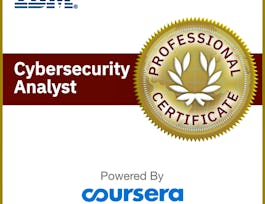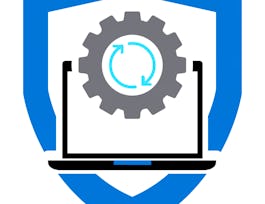If you are an associate-level cybersecurity analyst who is working in security operation centers, this course will help you acquire the fundamental skills required in a security operations center. You will learn the primary functions of a security operations center (SOC) and the critical role it plays in protecting organizational assets from cyber-attacks. By the end of the course, you will be able to:



Security Operations Center (SOC)
This course is part of Cybersecurity Operations Fundamentals Specialization

Instructor: Cisco Learning & Certifications
Sponsored by BIDAcademy
17,657 already enrolled
(218 reviews)
Skills you'll gain
- Cyber Operations
- Safety and Security
- Cyber Security Strategy
- Network Security
- Network Performance Management
- Computer Security Incident Management
- Event Monitoring
- System Monitoring
- Network Monitoring
- Security Management
- Security Controls
- Information Technology Operations
- Incident Management
- Cybersecurity
- Cyber Threat Hunting
- Security Information and Event Management (SIEM)
- IT Infrastructure
- Threat Detection
- Incident Response
- Systems Administration
Details to know

Add to your LinkedIn profile
29 assignments
See how employees at top companies are mastering in-demand skills

Build your subject-matter expertise
- Learn new concepts from industry experts
- Gain a foundational understanding of a subject or tool
- Develop job-relevant skills with hands-on projects
- Earn a shareable career certificate


Earn a career certificate
Add this credential to your LinkedIn profile, resume, or CV
Share it on social media and in your performance review

There are 8 modules in this course
If you are an associate-level cybersecurity analyst who is working in security operation centers, this course will help you acquire the fundamental skills required in a security operations center. You will learn the primary functions of a security operations center (SOC) and the critical role it plays in protecting organizational assets from cyber-attacks. By the end of the course, you will be able to: • Gain an understanding of SOC team member’s daily activities and responsibilities. • Identify who these bad actors are, their motives, why they attack, and what they attack. • Review the goals of implementing a SOC and covers the business benefits that an organization achieves by employing a SOC. • Introduce technical and procedural challenges in a SOC. To be successful in this course, you should have the following background: 1. Skills and knowledge equivalent to those learned in Implementing and Administering Cisco Solutions (CCNA) v1.0 course 2. Familiarity with Ethernet and TCP/IP networking 3. Working knowledge of the Windows and Linux operating systems 4. Familiarity with basics of networking security concepts.
What's included
6 videos6 readings4 assignments1 discussion prompt
If you are an associate-level cybersecurity analyst who is working in security operation centers, this lesson evaluates SOC processes and services. By the end of the course, you will be able to: • Understand primary responsibilities of a SOC and its interactions with other departments within the organization.• Understand various services that a SOC provides throughout the incident response phases. To be successful in this course, you should have the following background: 1. Skills and knowledge equivalent to those learned in Implementing and Administering Cisco Solutions (CCNA) v1.0 course 2. Familiarity with Ethernet and TCP/IP networking 3. Working knowledge of the Windows and Linux operating systems 4. Familiarity with basics of networking security concepts.
What's included
4 videos4 readings3 assignments
If you are an associate-level cybersecurity analyst who is working in security operation centers, this course will help you understand SOC types, staffing considerations, and deployment models and their consumers. By the end of the course, you will be able to: • Describe various SOC types and staffing considerations. • Describe SOC deployment models and their corresponding consumer profiles. To be successful in this course, you should have the following background: 1. Skills and knowledge equivalent to those learned in Implementing and Administering Cisco Solutions (CCNA) v1.0 course 2. Familiarity with Ethernet and TCP/IP networking 3. Working knowledge of the Windows and Linux operating systems 4. Familiarity with basics of networking security concepts.
What's included
4 videos8 readings3 assignments
If you are an associate-level cybersecurity analyst who is working in security operation centers, this course will help you to understand about staff that work in SOC and their personnel roles and titles. Describe the necessary skills to work in a SOC. By the end of the course, you will be able to: • Describe the role of each SOC member in general and in the context of incidence response. Describe the skill set of each SOC member and their toolkit components. • Describe the interactions of SOC members with each other and external entities in the context of incidence response. To be successful in this course, you should have the following background: 1. Skills and knowledge equivalent to those learned in Implementing and Administering Cisco Solutions (CCNA) v1.0 course 2. Familiarity with Ethernet and TCP/IP networking 3. Working knowledge of the Windows and Linux operating systems 4. Familiarity with basics of networking security concepts.
What's included
4 videos7 readings3 assignments
If you are an associate-level cybersecurity analyst who is working in security operation centers, this course will help you understand the data collection and data analytics activities performed in a SOC. Identify tools for performing data collection and analysis activities and how they complement each other. By the end of the course, you will be able to: • Describe SOC relevant data and security event data. • Describe SOC tools and their features. To be successful in this course, you should have the following background: 1. Skills and knowledge equivalent to those learned in Implementing and Administering Cisco Solutions (CCNA) v1.0 course 2. Familiarity with Ethernet and TCP/IP networking 3. Working knowledge of the Windows and Linux operating systems 4. Familiarity with basics of networking security concepts.
What's included
5 videos14 readings3 assignments
If you are an associate-level cybersecurity analyst who is working in security operation centers, this course will help you understand the importance of using effective tools and developing a good relationship with external organizations. Describe the most important tools and software the SOC team uses to achieve this goal. By the end of the course, you will be able to: • Describe intelligence resources, regulatory agencies, and government industry organizations with which the SOC communicates. • Describe the policies, procedures, and governance rules to integrate with SOC procedures that define how it engages with users, HR, and legal in response to detected violations of procedures. To be successful in this course, you should have the following background: 1. Skills and knowledge equivalent to those learned in Implementing and Administering Cisco Solutions (CCNA) v1.0 course 2. Familiarity with Ethernet and TCP/IP networking 3. Working knowledge of the Windows and Linux operating systems 4. Familiarity with basics of networking security concepts.
What's included
4 videos6 readings3 assignments
If you are an associate-level cybersecurity analyst who is working in security operation centers, this course will help you explain the use of SOC metrics to measure the effectiveness of the SOC. By the end of the course, you will be able to: • Explain security data aggregation. • Explain Time to Detection (TTD) in context to network security. • Describe security controls detection effectiveness. • Describe SOC metrics. To be successful in this course, you should have the following background: 1. Skills and knowledge equivalent to those learned in Implementing and Administering Cisco Solutions (CCNA) v1.0 course 2. Familiarity with Ethernet and TCP/IP networking 3. Working knowledge of the Windows and Linux operating systems 4. Familiarity with basics of networking security concepts.
What's included
6 videos6 readings5 assignments
If you are an associate-level cybersecurity analyst who is working in security operation centers, this course will help you understand the use of a workflow management system and automation to improve the effectiveness of the SOC. By the end of the course, you will be able to: • Describe SOC WMS concepts. • Describe how a typical workflow management system is integrated within a SOC.• Describe SOC WMS integration. • Provide an example of SOC workflow automation. To be successful in this course, you should have the following background: 1. Skills and knowledge equivalent to those learned in Implementing and Administering Cisco Solutions (CCNA) v1.0 course 2. Familiarity with Ethernet and TCP/IP networking 3. Working knowledge of the Windows and Linux operating systems 4. Familiarity with basics of networking security concepts.
What's included
7 videos14 readings5 assignments
Instructor

Offered by
Why people choose Coursera for their career




Learner reviews
218 reviews
- 5 stars
84.93%
- 4 stars
12.78%
- 3 stars
0.45%
- 2 stars
1.36%
- 1 star
0.45%
Showing 3 of 218
Reviewed on Oct 2, 2023
Week 8 presentations were pretty dry by using a Powerpoint presentation and audio quality was lacking.
Reviewed on Jul 26, 2023
A great introductory course to SOC. Thanks Cisco and Cousera!
Reviewed on Jun 9, 2024
I had no idea what the roles and responsibilities of a SOC analyst were. Now I know
Recommended if you're interested in Information Technology

Open new doors with Coursera Plus
Unlimited access to 10,000+ world-class courses, hands-on projects, and job-ready certificate programs - all included in your subscription
Advance your career with an online degree
Earn a degree from world-class universities - 100% online
Join over 3,400 global companies that choose Coursera for Business
Upskill your employees to excel in the digital economy






